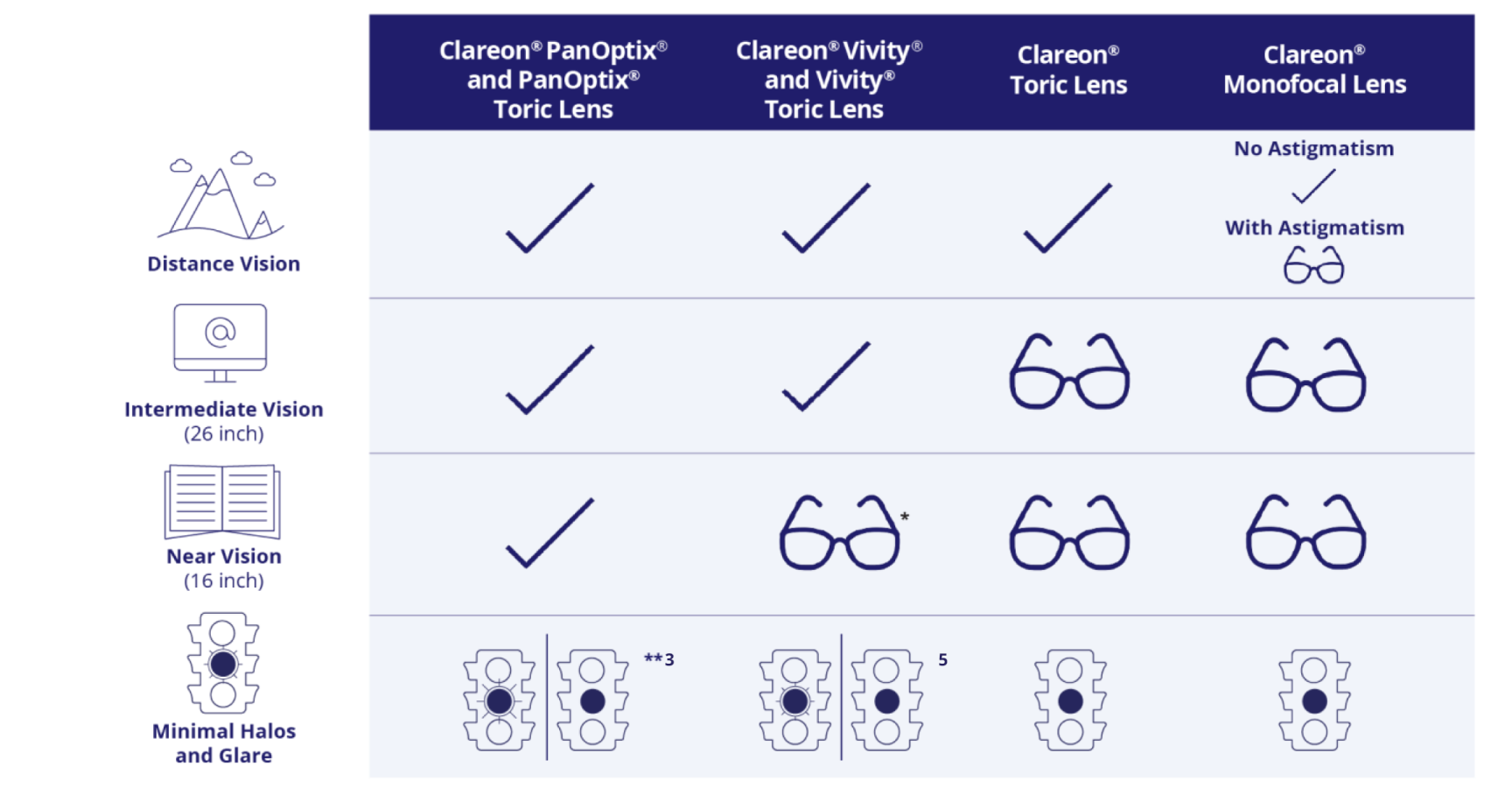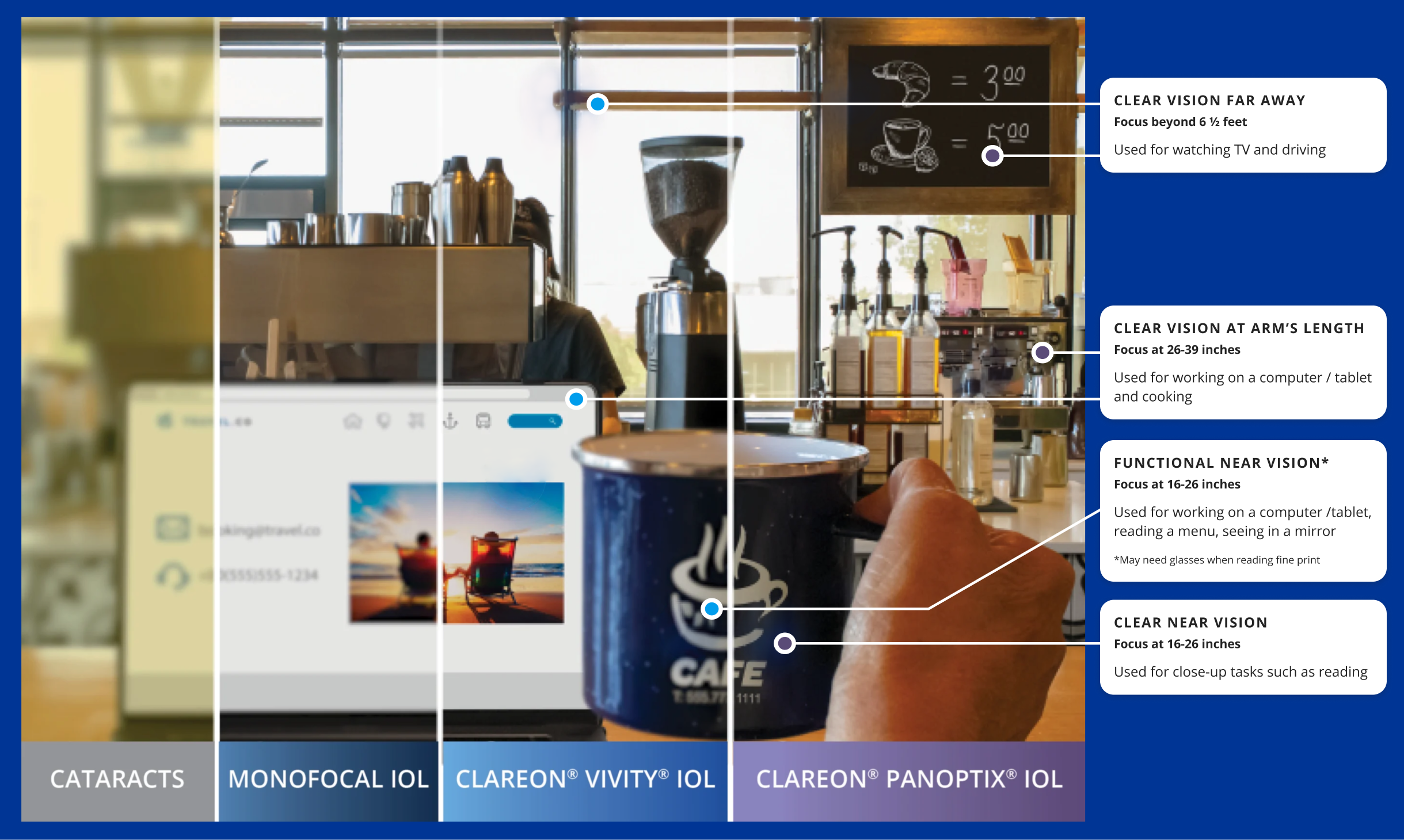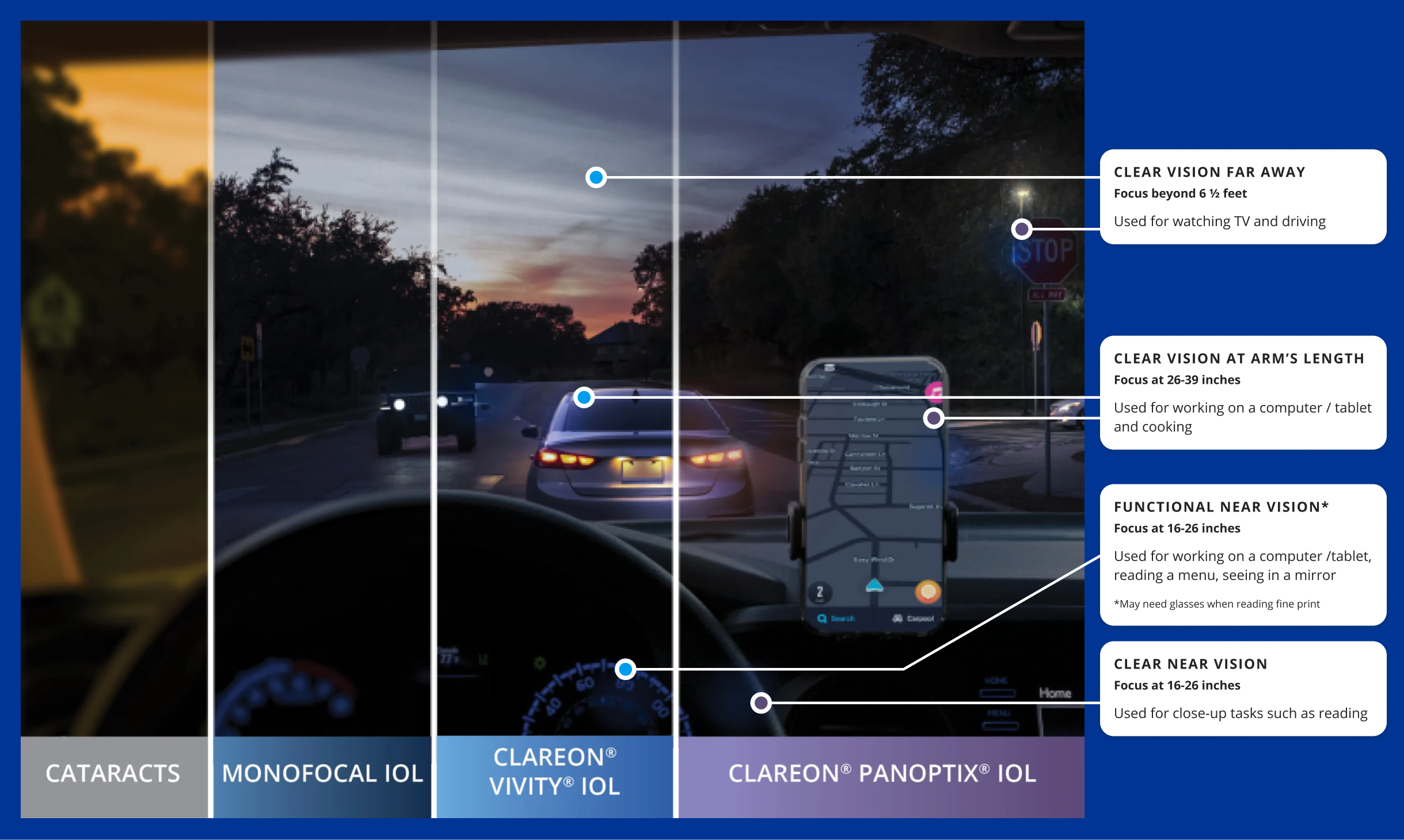CLAREON® COLLECTION
Explore your cataract replacement lens options, and start planning a life after cataract surgery
Discover your full spectrum of vision options
Have you or someone you love been diagnosed with cataracts? When it comes to cataract surgery, you have options. The type of intraocular cataract replacement lens you choose should align to the kind of vision you want after cataract surgery.
Half of patients say they had the vision of someone 10+ years younger after cataract surgery.1

See what life looks like after cataract surgery
Cataract surgery involves removing the natural lens in the eye that has become cloudy, and replacing it with an artificial lens (known as an intraocular lens or IOL). Depending on the lens you choose with your surgeon, cataract surgery may also help you become less dependent on glasses or contact lenses, or even remove the need for them altogether.2
It’s important to discuss your lens options with your surgeon prior to surgery to ensure you get the lens most suited to your needs.

Find the right lens for you

Clareon® PanOptix®
The first trifocal lens available in the United States. Enjoy a full range of vision and exceptional clarity, and reduce your need for glasses.3,4

Clareon® Vivity®
Allows you to see clearly at far and intermediate distances.5 You may require glasses for reading small print.5

Clareon® Toric
Provides clear distance vision while correcting astigmatism.6 You may need glasses for clear near and intermediate vision.6

Clareon® Monofocal
Provides clear distance vision.7-9 You may need glasses for clear near and intermediate vision.9
AT A GLANCE
Clareon® intraocular lenses side-by-side
Discuss your cataract replacement lens options with your surgeon to ensure you receive the lens most suited to your needs. How glasses-free would you like to be?


*Some Vivity® patients may find tasks like reading fine print are improved by wearing glasses.
**Some PanOptix® patients may experience visual disturbances such as a halo around bright lights.
Find the Clareon® intraocular lens that fits your lifestyle
Start the conversation
You have options when it comes to your intraocular lenses. Lead the conversation with your doctor to understand the cataract lens choice that’s right for you.
Find a cataract surgeon near you
Use our Cataract Surgeon Finder tool to locate a surgeon near you who offers a range of IOL options

IMPORTANT PRODUCT INFORMATION - CLAREON® FAMILY OF IOLS
CAUTION: Restricted by law to sale by or on the order of a physician.
DESCRIPTION: The Clareon® Family of Lenses are artificial lenses implanted in the eye of adult patients following cataract surgery. The Clareon® Aspheric Hydrophobic Acrylic IOLs are designed to allow for clear distance vision. However, you will likely still need glasses for reading and for distance vision particularly if you already have astigmatism. The Clareon® PanOptix® Trifocal Hydrophobic IOL is a type of multifocal lens (sometimes called “presbyopia-correcting IOL”) designed to allow for clear distance, intermediate, and near vision with the potential to be more independent of the need to use glasses for daily tasks. The Clareon® Vivity® Extended Vision Hydrophobic Posterior Chamber IOL provides clear distance vision, and better intermediate and some near vision compared to a monofocal IOL. The Clareon® Aspheric Toric, Clareon® PanOptix® Toric, and Clareon® Vivity® Toric IOLs are also designed to correct pre-existing corneal astigmatism, which is the inability of the eye to focus clearly at any distance because of difference curvatures on the cornea, and provide distance vision.
WARNINGS / PRECAUTIONS: You may experience and need to contact your eye doctor immediately if you have any of the following symptoms after cataract surgery: itching, redness, watering of your eye, sensitivity to light. The safety and effectiveness of these IOLs have not been established in patients with eye conditions, such as an increase in eye pressure (glaucoma) or complications of diabetes in the eye (diabetic retinopathy). As with any surgical procedure, there are risks involved. These risks may include but are not limited to infection, damage to the lining of the cornea, the retinal layer which lines the inside back wall of your eye may become separated from the tissue next to it (retinal detachment), inflammation or swelling inside or outside the eye, damage to the iris (the colored diaphragm around the pupil), or an increase in eye pressure that cannot be controlled by medicine and secondary surgical procedure. There is a possibility that the IOL may be placed incorrectly or could move within the eye. This may result in less improvement or a reduction in vision, or it may cause visual symptoms. The Clareon® Aspheric Toric, Clareon® PanOptix® Toric, and Clareon® Vivity® Toric IOLs correct astigmatism only when placed in the correct position in the eye. There is a possibility that these Toric IOLs could be placed incorrectly or could move within the eye. This may result in less improvement or a reduction in vision because your astigmatism has not been fully corrected, or it may cause visual symptoms. With the Clareon® PanOptix® and Clareon® Vivity® IOLs, there may be a loss of sharpness of your vision that may become worse in dim light or in foggy conditions. There is also a possibility that you may have some visual effects such as rings or circles (halos) around lights at night. You may also have trouble seeing street signs due to bright lights or glare from oncoming headlights.
ATTENTION: As with any surgical procedure, there are risks involved. Prior to surgery, ask your eye doctor to provide you with the Patient Information Brochure for the lens to be implanted. This Brochure which will inform you of the risks and benefits associated with the IOL. Discuss any questions about possible risks and benefits associated with your eye doctor.
REFERENCES
1. Based on a survey of post-surgery cataract patients (n=288); Alcon data on file, 2023.
2. Factors to Consider in Choosing an IOL for Cataract Surgery https://www.aao.org/eye-health/tips-prevention/bestartificial-lens-implant-iol-cataract-surgery Published Dec. 12, 2022. Accessed on March 7, 2023.
3. Clareon® PanOptix® Trifocal Hydrophobic Acrylic IOL Model CNWTT0 2021
4. Zhu D, Ren S, Mills K, Hull J, Dhariwal M. Rate of Complete Spectacle Independence with a Trifocal Intraocular Lens: A Systematic Literature Review and Meta-Analysis. Ophthalmol Ther. 2023;12(2):1157-1171.
5. Clareon® Vivity® Extended Vision Hydrophobic IOL (CNWET0) Directions for Use – USA.
6. Clareon® Toric Directions for Use.
7. Lehmann R, Maxwell A, Lubeck DM, Fong R, Walters TR, Fakadej A. Effectiveness and Safety of the Clareon Monofocal Intraocular Lens: Outcomes from a 12-Month Single-Arm Clinical Study in a Large Sample. Clin Ophthalmol. 2021;15:1647-1657. Published 2021 Apr 20.
8. Werner L, Thatthamla I, Ong M, et al. Evaluation of clarity characteristics in a new hydrophobic acrylic IOL. J Cataract Refract Surg. 2019;45: 1490-1497.
9. Alcon data on file, 2023.


